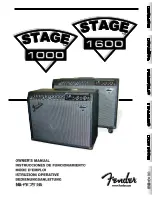
HANDLING AND CARE
• Keep the amp safe from hard knocks and shocks. Tubes are fragile and tend to suffer when exposed
to mechanical stress!
• Let the amp cool down before you transport it. Ten minutes or so will spare the tubes.
• Tubes take some 20 seconds to warm up after you switch the power on, and about two to three
minutes before they are able to pump out full power. Make a habit of giving your amp plenty of time to
get toasty and flipping the Standby switch for short breaks.
• In order to spare the power tubes and prolong their lifetime, we recommend to set the Stand By
switch to (0 position, that is) before you switch the amp on. After a period of 30 seconds you may
activate the power amp by flipping the Stand By switch.
• Avoid storing the amp in damp or dusty rooms to spare jacks, switches and potentiometers. If you
don‘t use the amp all the time, we recommend that you drape a covering over it to prevent the in-
trusion of dust. Even better, keep it in a transport cover or flight case.
• Never use caustic or scouring detergents to clean the amp‘s housing, front or rear panels. Use a soft,
damp cloth or sponge with diluted soapsuds or a standard brand of mild dishwashing liquid instead.
Never use solvents they can corrode the amp‘s vinyl skin and dissolve the front and rear panel labels.
Keep liquids well away from the amp, particularly the interior of the housing. * Make sure air can
circulate at the rear and top of the amp to allow for adequate cooling, which increases component life.
• Never operate the amp without an adequate load (a speaker, cabinet or suitable terminating resistor).
• High ambient temperatures place an additional strain on diverse components; so if at all possible,
avoid operating the amp at temperatures far higher than 30°C for longer periods. Running the amp
at mains voltages exceeding the nominal mains input voltage over longer periods can also shorten
component life.
• Replace tubes with selected tubes that satisfy ENGL selection criteria to forestall microphonic pro-
perties, undesirable noise and unbalanced power amp signals. Because power tubes‘ idle current
(bias) must checked and possibly adjusted when replacing tubes, this is a job best left to experienced
and authorized specialists.
Attention! Be sure to read this section before powering the amp up!
A few comments on tube amplifiers:
• This amp´s input is extremely sensitive due to its high gain factor.
• This guitar amplifier can produce high volume levels. Exposure to high volume levels may cause hea-
ring damage!
• Leave tube replacement and power amp biasing to qualified professionals.
• Be sure the unit is switched off and unplugged!
• Caution! Tubes can get very hot and burn skin when touched. Always use high quality cables.
• Never plug the amp into an ungrounded outlet!
• Never bridge a defective fuse and be sure replacement fuses feature identical ratings!
• Pull the AC mains plug before replacing fuses!
• Never open the chassis or attempt repairs on your own. Consult qualified service personnel!
• Never expose the amplifier to extreme humidity or dampness!
• Please read the instructions carefully before operating the unit!
Содержание E610II
Страница 1: ...E610II Savage 120 II E630II Savage 60 II Operator s Manual...
Страница 24: ...www engl amps com...






































